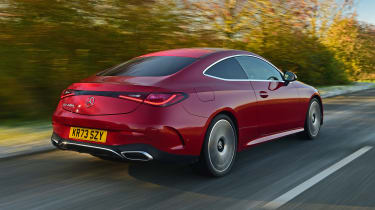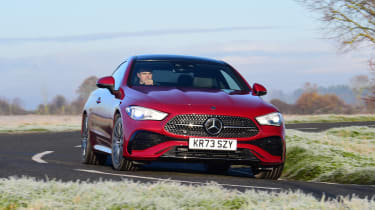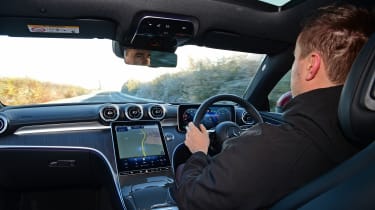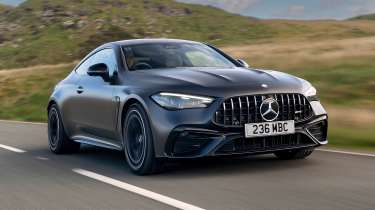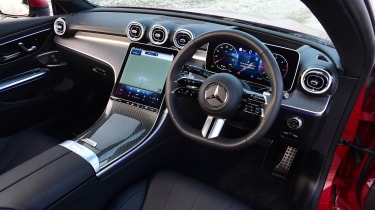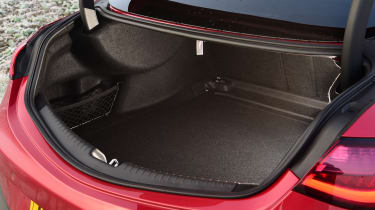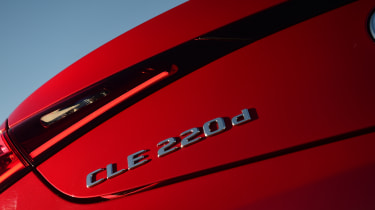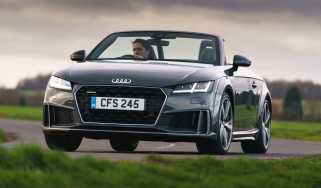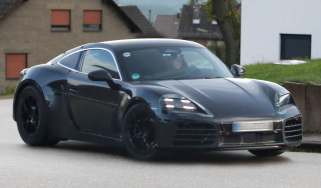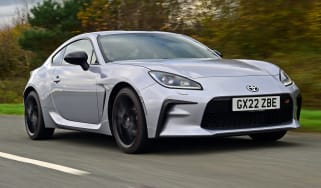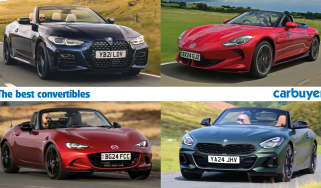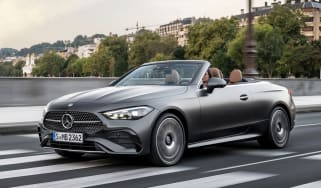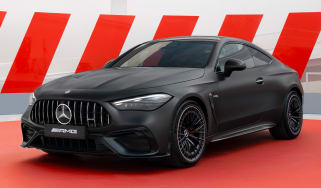Mercedes CLE review – kills two birds with one stone
“The Mercedes CLE looks good, offers a decent amount of room inside and drives well, replacing two models in one go”
Pros
- Attractive styling
- Good to drive
- Fairly spacious
Cons
- Can get expensive
- AMG 53 model lacks drama
- Rivals have slightly more boot space
Verdict - Is the Mercedes CLE a good car?
In the quest to replace two models with one, the resulting Mercedes CLE is a perfectly solid new contender amongst executive coupes. Its styling should appeal to a broad audience, it’s comfortable, and the interior boasts the usual Mercedes wow factor. As one of Merc’s last newly-designed petrol models, it doesn’t really move the game on in any real sense, but as a last hurrah for more traditional buyers, it should hold plenty of appeal. Unfortunately the AMG 53 version doesn’t feel fun or special enough to recommend buying it over one of the cheaper standard models.
Mercedes CLE models, specs and alternatives
Mercedes has consolidated its lineup by combining the C-Class and E-Class coupes into this: the Mercedes CLE coupe. There’s also a CLE convertible for those who like the wind in their hair, and we’ve reviewed that model separately. This streamlining of the brand’s lineup coincides with the rise in popularity of SUVs and new electric models, with much of Mercedes’ focus on expanding those areas of its lineup instead. The CLE is a model primed to compete with the BMW 4 Series and Audi A5 head-on.
In terms of size, the CLE is actually slightly longer than the E-Class Coupe, but with a fractionally smaller wheelbase (the space between the front and rear axles). As a result, headroom and legroom are between the two outgoing models but much closer to the E-Class, with a 420-litre boot that’s slightly smaller than the BMW 4 Series (440 litres) and A5 Coupe (450 litres) offer.
More reviews
The CLE will be one of the very last all-new Mercedes models designed primarily for combustion engines. These are mostly mild-hybrids, and a 2.0-litre petrol and diesel form the core of the range, badged 300 4Matic and 220 d respectively. A 3.0-litre six-cylinder petrol engine is the flagship of the regular range and is badged 450 4Matic outputting a healthy 375bhp. Above this is the performance-oriented AMG CLE 53, which bumps power up to 442bhp thanks to its twin-turbo setup.
A CLE 300 e plug-in hybrid was added to the range in 2024, using a 201bhp 2.0-litre engine paired with a 127bhp electric motor. It has the added benefit of being able to run on electric power for up to 69 miles. That gives it a lofty 201mpg official figure, but you’ll have to keep it regularly charged to have any chance of matching it. Low CO2 emissions should make it the cheapest to purchase as a company car because of its low BiK (Benefit-in-Kind) tax rating.
A nine-speed automatic gearbox is standard, and while the CLE might not be intended to be one of Mercedes’ most efficient models, the CLE 200 petrol engine can return up to 44.1mpg, while the 220 d diesel can return 60.1mpg.
Not only is the AMG CLE 53 more powerful, it also gets a wider, lower stance and a raft of tweaks to its chassis to make it more nimble. While at the time of writing it’s the most hardcore model on offer, it’s not quite as engaging as you’d expect. An AMG CLE 63 will arrive later and it’s expected to get a gruntier V8 engine, but for now the AMG 53 is the happy medium between a full-fat AMG car and the standard range.
Every version of the CLE comes well-equipped, and the widescreen TFT displays that sweep across the dashboard look a step on from what’s offered in the Audi A5. It’s a nice place to sit, enhanced by 64 different colour combinations for the ambient lighting and lots of upmarket materials. While it’s a pricey option, the Burmester stereo upgrade also feels fitting here and delivers amazing audio quality as you cruise along in style.
|
Trim levels |
Power options |
|
|
Mercedes CLE alternatives
The luxury four-seat coupe market has dwindled in recent years as more buyers flock to SUVs, but there are still a few desirable contenders from established players.
MPG, running costs & CO2 emissions
Considering the fact the Mercedes CLE is a car you’ll likely buy with your heart as much as your head, it’s actually rather sensible to run. The entire range is electrified, so most models get mild-hybrid assistance, while a plug-in hybrid 300 e model was added later.
The mild-hybrid tech recuperates energy into a small battery under deceleration, before using it to give the combustion engine a small helping hand. This helps the entry-level petrol CLE 200 achieve 44.1mpg, with CO2 emissions from 145g/km. The flagship CLE 450 is likely to remain a niche choice, and it’s fairly thirsty, returning from 36.2mpg. While diesel sales are dwindling in the UK, Mercedes still offers the 220 d for now, and it’s likely to be your best bet for lots of long-distance motoring, returning a frugal 60.1mpg in official figures – when we tested it we found this figure hard to achieve in the real world, though fuel economy was still good for a car this size, at over 50mpg.
Even the CLE AMG 53 gets the same mild-hybrid technology, but with performance the clear focus here, emissions shoot up to 217g/km and it’s also thirsty, returning just 29.4mpg despite its sleek low-drag bodywork.
Mercedes added a plug-in hybrid, badged the 300 e in 2024. This model can run on electricity for up to 69 miles, which will come in perfect for shorter trips around town and help save on fuel. As a result it gets an official fuel economy of 201mpg, but that’s only possible if you keep it regularly charged. This is likely to be the most attractive model for company-car buyers as low CO2 emissions of 13g/km put it in a low BiK (Benefit-in-Kind) tax band.
With prices starting from around £50,000, the Mercedes CLE is liable for luxury car tax, so it will cost more than £500 per year in VED (road tax) in years two to six, before returning to the standard rate.
|
Model |
Fuel economy |
CO2 emissions |
|
CLE 220 d |
60.1mpg |
123g/km |
|
CLE 200 |
44.1mpg |
145g/km |
|
CLE 200 4Matic |
42.2mpg |
153g/km |
|
CLE 300 4Matic |
40.4mpg |
159g/km |
|
CLE 300 e |
201mpg | 13g/km |
|
CLE 450 4Matic |
36.2mpg |
176g/km |
|
CLE 53 4Matic+ |
29.4mpg |
217g/km |
Insurance
Insurance groups for the Mercedes CLE start from group 35, which is surprisingly slightly lower than the C-Class saloon, which finds itself in groups 38 to 45. The CLE 220 d is in groups 36 to 38, while the CLE 450 finds itself in group 43, and despite its significant power hike, the CLE 53 is only positioned one group higher. These groupings are slightly higher than those of the BMW 4 Series, which sits in groups 30 to 42.
Engines, drive & performance
Models like the Mercedes CLE find themselves in an interesting spot, because they need to feel as sporty as their rakish looks suggest, but also cosset the driver and passengers on a longer trip. None of the current engines on offer make the CLE a hot rod, but it feels fluid and covers ground at a surprising rate.
Of the standard CLE range we’ve so far tested the CLE 300 4Matic and 220 d. The 300 4Matic feels like it generates speed pretty effortlessly as it goes up and down its nine-speed automatic gearbox. Despite being ‘only’ a 2.0-litre petrol engine with 255bhp, the fact its mild hybrid system can help generate 605Nm of torque in short bursts helps to explain why it shrugs off its significant mass of over 1,800kg.
Similarly, when we drove the 220 d on UK roads, we found that while it only offers 194bhp, it has plenty of pulling power for most drivers, without feeling particularly sporty. It’s well suited for long cruises, though, with a smooth power delivery and a subtle but satisfying grumble from the engine. There is a Sport mode, but aside from making the steering feel weightier and sharpening up the throttle response, it doesn’t change the driving experience all that much.
The CLE comes with four-wheel steering, with the rear wheels turning up to 2.5 degrees and helping it feel slightly more agile in the bends. The steering feels very light, though, and there’s not much feedback from the road or chassis through the wheel.
We also found that the low-profile tyres fitted to our test car’s 20-inch wheels produced quite a lot of road noise, although this may be marginally better on cars fitted with the standard 18-inch and 19-inch alloys. Happily, however, there’s little wind noise thanks to the CLE’s aerodynamic shape.
The CLE’s soft suspension setup coped well with bigger imperfections in the road, but smaller surface blemishes could be felt all too often – again this may be less noticeable on cars fitted with smaller wheels.
We’ve now also driven the CLE AMG 53, which gets a twin-turbocharged version of the 3.0-litre six-cylinder engine. There’s no doubt that it’s brisk with its 4.2-second 0-62mph time, but it’s not as hardcore as some keener drivers would like. While its engine is bassy and by no means sounds bad, it delivers quite a distant, muted and diluted noise which lacks the same sort of character you’d get from AMG models of old.
What is noticeable about the AMG 53 is how it’s able to feel more agile than the standard models and yet it remains very comfortable. The steering feels accurate and fast, which is helped by its four-wheel steering system, but there still isn’t much in the way of feedback through the steering wheel. Avid drivers would be better off waiting to try the AMG 63 which will arrive later for the full-fat experience, because we don’t think the AMG 53 is worth the extra outlay for the slight increase in power.
Petrol models
Petrol engines make up the bulk of the Mercedes CLE range, and there are three in the standard range for British buyers to pick from. The entry-level CLE 200 uses a 2.0-litre four-cylinder with 201bhp, which can be upgraded to 255bhp in the CLE 300 that gets 4Matic all-wheel drive as standard. While these aren’t massive power outputs in the era of scorching EVs, they’re likely to feel plenty quick enough for most drivers buying the CLE more for its design than its ability to set lap times.
Even the CLE 450 4Matic with 376bhp could only be described as “brisk” for a coupe brandishing the three-pointed star, and it goes head-to-head with the BMW M440i XDrive with 374bhp.
Above this sits the Mercedes-AMG version for performance-car fans, but despite turning out impressive numbers its engine is something of a disappointment. Its 3.0-litre six-cylinder turbocharged petrol is based on that found in the CLE 450, but with a series of AMG-developed adaptations and turned-up turbocharging to get it up to 449bhp. Oddly, though, a somewhat lazy character means it never feels as quick as you think it should, and it fails to match the character of the outgoing AMG C 63 Coupe’s engine.
|
Model |
Power |
0-62mph |
Top speed |
|
CLE 200 |
201bhp |
7.4s |
149mph |
|
CLE 200 4Matic |
201bhp |
7.5s |
147mph |
|
CLE 300 4Matic |
255bhp |
6.2s |
155mph |
|
CLE 450 4Matic |
375bhp |
4.4s |
155mph |
|
CLE AMG 53 4Matic+ |
442bhp |
4.2s |
155mph |
Plug-in hybrid models
A PHEV version of the CLE was added later on, badged 300 e. It gets a 201bhp 2.0-litre petrol engine and 127bhp electric motor, for a combined output of just over 300bhp. This will allow a plug-in CLE to drive silently when desired and get from 0-62mph in 6.3 seconds.
|
Model |
Power |
0-62mph |
Top speed |
|
CLE 300 e |
201bhp (combustion engine) 127bhp (electric motor) |
6.3s |
147mph |
Diesel models
If you often travel long distances, the 2.0-litre turbodiesel could also be worth considering. It’s fitted with a variable turbine geometry turbo that can adapt to work more effectively over a wider range of engine speeds, so it can provide its maximum 440Nm of pulling power from just 1,800rpm.
|
Model |
Power |
0-62mph |
Top speed |
|
CLE 220 d |
194bhp |
7.5s |
149mph |
Interior & comfort
Thanks to its shared platform with the C-Class, the CLE doesn’t feel too different from that car inside, which sparks no complaints from us. The driver and front passenger sit in a cocoon-like cabin, separated by a large centre console, with a storage compartment doubling as an armrest.
Jet-like air vents arranged across the dashboard add to the visual flair, and everything looks and feels tasteful and upmarket. While buttons have mostly been relegated to the parts bin, there are numerous steering wheel controls for important functions. Ambient lighting with 64 colours sees the cabin come alive when the sun sets, with the comfortable front seats offering heating, cooling and even massaging functions.
We had some qualms with the amount of piano-black surfaces used in the CLE, because of their tendency to show fingerprints and the like, and some larger pieces of trim creak a little too much for our liking, especially considering this is a premium model with a price tag to match. The CLE 53 gets quite a few changes, including more aggressive exterior looks, lots of ‘AMG’ badges inside and out, and features like a sports steering wheel to give the interior a motorsport-inspired theme.
Despite the CLE Coupe being a relatively niche model, there are no less than four trim levels, before you even consider the Mercedes-AMG versions. They start with AMG Line, with 18-inch alloy wheels, ambient lighting, Adaptive High Beam headlights and interior features including keyless and heated front seats. AMG Line Plus adds bigger wheels, a panoramic sunroof and more advanced headlights, while AMG Line Premium Plus goes further with 20-inch alloys, a head-up display and Burmester stereo. Above all of these sits the Premier Edition, costing from just shy of £57k and featuring black exterior trim, a unique bi-colour wheel design and a heated steering wheel.
It doesn’t end there, because the AMG CLE 53 is offered in AMG Premium or the stealthy-looking AMG Night Edition Premium Plus guises. The latter can be made more extreme with a £7,500 Pro Performance pack, adding figure-hugging bucket seats, a carbon and microfibre AMG steering wheel. It also brings a rear spoiler and exterior styling makeover, along with an additional ‘Race’ driving setting, with ‘Race start and drift’ modes, so while it looks eye-wateringly expensive it might not in fact represent bad value – we just wish they were included as standard.
Infotainment and navigation
There’s a 12.3-inch central touchscreen ahead of the centre console and an 11.9-inch driver’s display, both running the latest MBUX infotainment software. While not quite as customisable as some rival systems, it features clear and crisp graphics, with snappy responses thanks to a more powerful new processor. While an abundance of information and configurations meant it was a little daunting to use at first, we found it easy to use after a day or two, even while on the move.
Key features | |
|
Trim name AMG Line
|
AMG Line Premium (AMG Line plus...)
|
|
AMG Line Premium Plus (AMG Premium plus...)
|
Premier Edition (AMG Line Premium Plus plus...)
|
Practicality & boot space
The CLE might replace both the C-Class Coupe and E-Class Coupe, but it’s nearer the latter model in terms of size. That’s good news for occupants, and the sort of buyers the CLE is aimed at, who may well want to head off on far-flung adventures or fill the boot with golf clubs.
Still, adults will need to be reasonably agile to squeeze into the back seats, and anyone approaching six feet tall will find themselves rubbing against the sloping headliner. It’s actually slightly more roomy than the BMW 4 Series and Audi A5 Coupe, though, so it’s not a bad pick if you’re planning on using the rear seats. If you’re considering the CLE 53, its rear seating is far more generous than you’ll find in a Porsche 911, even if its low roofline is likely to get rather claustrophobic after a few hours.
|
Size comparison | |||
|
Model |
Length |
Width |
Height |
|
Mercedes CLE |
4,850mm |
1,860mm |
1,428mm |
|
BMW 4 Series |
4,794mm |
1,852mm |
1,383mm |
|
Audi A5 Coupe |
4,697mm |
1,846mm |
1,371mm |
|
Lexus RC |
4,710mm |
1,845mm |
1,390mm
|
Boot space
It’s a bit of a mixed bag here, because while the CLE boasts a 60-litre bigger boot than the outgoing C-Class Coupe, it’s five litres down on the E-Class Coupe. More importantly, its 420-litre volume is smaller than both the A5 Coupe and 4 Series, so if boot space is really vital, you may want to consider one of those cars instead.
Still, 420 litres is hardly small for a stunning coupe, being larger than you’ll find in most family hatchback models that people use as their cars every day of the year.
Some boot space is missing in the CLE AMG 53 model, which is 10 litres down on the standard car, while the plug-in hybrid 300 e’s boot is much smaller at just 290 litres to accommodate the electric motor and battery. It’s seriously worth weighing up whether you’d rather the extra efficiency gains or practicality before you commit.
|
Boot space comparison | |
|
Model |
Boot space |
|
Mercedes CLE |
420 litres |
|
BMW 4 Series |
440 litres |
|
Audi A5 Coupe |
450 litres |
|
Lexus RC |
366 litres |
Reliability & safety
Mercedes has real pedigree when it comes to safety, so you can expect not only a strong car with lots of crash protection, but also the latest driving aids. Despite being the oldest manufacturer of passenger cars, reliability is a bit more of a thorny issue. While Mercedes’ models are built to a high standard, the manufacturer only came 25th out of 32 brands in our latest 2024 Driver Power survey.
26% of Mercedes owners reported a fault within the first year of ownership, which is at least 2% less than the previous year’s results. Mercedes scored well for its engines and infotainment, but fell down in areas like value for money, running costs and quality.
Safety
As you’d expect from a Mercedes costing over £50,000, there’s lots of kit to keep you out of harm's way. This includes a myriad of sensors that ensure you aren’t drifting out of your lane, or worse, and also keep an eye on you to recommend a break as soon as it senses you’re tired or distracted. It’s not yet known if Euro NCAP will crash test the CLE separately, but it’s reassuring to note the Mercedes C-Class already received a five-star rating in 2022, with an impressive 93% score for adult occupant protection.
Which Is Best?
Cheapest
- NameCLE 200 AMG Line 2dr 9G-Tronic
- Gearbox typeSemi-auto
- RRP£47,395
Most Economical
- NameCLE 300e AMG Line Premium 2dr 9G-Tronic
- Gearbox typeSemi-auto
- RRP£62,100
Fastest
- NameCLE 53 4Matic+ AMG Premium 2dr 9G-Tronic
- Gearbox typeSemi-auto
- RRP£74,590

